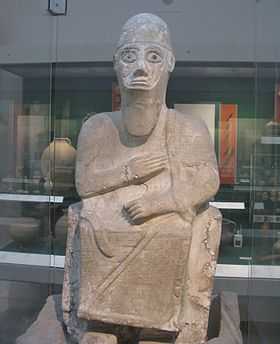Statue of Idrimi
|
The Statue of Idrimi | |
| Material | Magnesite |
|---|---|
| Size | 104cm high |
| Created | 16th century BC |
| Present location | British Museum, London |
| Identification | 1939,0613.101 |
The inscription includes the "first certain cuneiform reference" to Canaan.[3]
Discovery
The Statue of Idrimi was discovered by Woolley in the ruins of a temple at the site of Tell Atchana, ancient Alalakh in the province of Hatay, Turkey. The statue had been badly damaged, presumably at a time of invasion or civil war, in around 1100 BC. The statue's head and feet had been broken off and it been deliberately toppled off its pedestal.
Description
The statue is carved of hard white dolomitic magnesite and the eyebrows, eyelids and pupils are inlaid with glass and black stone. The king, who is seated on a throne, wears a round-topped crown with band and neck-guard and a garment with narrow borders. King Idrimi is depicted crossing his right arm above the left. An inscription covers large parts of the body.
Inscription
The inscription on the statue is written in Akkadian, using cuneiform script. It describes the exploits of King Idrimi and his family. The inscription tells how, following a dispute, Idrimi and his family were forced to flee Iamhad (Aleppo) to his mother's family at Emar (now Meskene) on the river Euphrates. Determined to restore the dynasty's fortunes, Idrimi left Emar and travelled to Canaan where he made a treaty with the king of Umman-Manda, rallied troops and mounted a seaborne expedition to recover the lost territory from the Hittites. He eventually became a vassal of King Barattarna who installed him as king in Alalakh, which he ruled for 30 years. The inscription ends with curses on anyone who desecrates or destroys the statue.
Gallery
-
Detail of the upper part of the Statue of Idrimi
References
- ↑ British Museum Highlights
- ↑ British Museum Collection
- ↑ Drews 1998, p. 46: "An eighteenth-century letter from Mari may refer to Canaan, but the first certain cuneiform reference appears on a statue base of Idrimi, king of Alalakh c. 1500 BCE."
Further reading
- T.C. Mitchell, The Bible in the British Museum (London, The British Museum Press, 1988)
- D. Collon, Ancient Near Eastern art (London, The British Museum Press, 1995)
- Drews, Robert (1998), "Canaanites and Philistines", Journal for the Study of the Old Testament 81: 39–61
